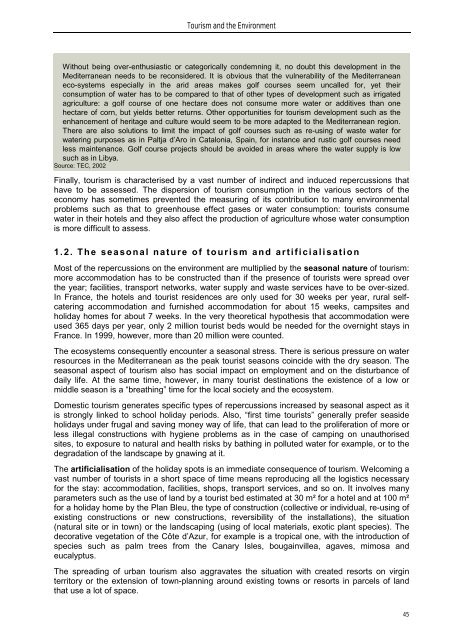dossier sur le tourisme et le développement durable
dossier sur le tourisme et le développement durable
dossier sur le tourisme et le développement durable
Create successful ePaper yourself
Turn your PDF publications into a flip-book with our unique Google optimized e-Paper software.
Tourism and the Environment<br />
Without being over-enthusiastic or categorically condemning it, no doubt this development in the<br />
Mediterranean needs to be reconsidered. It is obvious that the vulnerability of the Mediterranean<br />
eco-systems especially in the arid areas makes golf courses seem uncal<strong>le</strong>d for, y<strong>et</strong> their<br />
consumption of water has to be compared to that of other types of development such as irrigated<br />
agriculture: a golf course of one hectare does not consume more water or additives than one<br />
hectare of corn, but yields b<strong>et</strong>ter r<strong>et</strong>urns. Other opportunities for tourism development such as the<br />
enhancement of heritage and culture would seem to be more adapted to the Mediterranean region.<br />
There are also solutions to limit the impact of golf courses such as re-using of waste water for<br />
watering purposes as in Paltja d’Aro in Catalonia, Spain, for instance and rustic golf courses need<br />
<strong>le</strong>ss maintenance. Golf course projects should be avoided in areas where the water supply is low<br />
such as in Libya.<br />
Source: TEC, 2002<br />
Finally, tourism is characterised by a vast number of indirect and induced repercussions that<br />
have to be assessed. The dispersion of tourism consumption in the various sectors of the<br />
economy has som<strong>et</strong>imes prevented the mea<strong>sur</strong>ing of its contribution to many environmental<br />
prob<strong>le</strong>ms such as that to greenhouse effect gases or water consumption: tourists consume<br />
water in their hotels and they also affect the production of agriculture whose water consumption<br />
is more difficult to assess.<br />
1.2. The seasonal nature of tourism and artificialisation<br />
Most of the repercussions on the environment are multiplied by the seasonal nature of tourism:<br />
more accommodation has to be constructed than if the presence of tourists were spread over<br />
the year; facilities, transport n<strong>et</strong>works, water supply and waste services have to be over-sized.<br />
In France, the hotels and tourist residences are only used for 30 weeks per year, rural selfcatering<br />
accommodation and furnished accommodation for about 15 weeks, campsites and<br />
holiday homes for about 7 weeks. In the very theor<strong>et</strong>ical hypothesis that accommodation were<br />
used 365 days per year, only 2 million tourist beds would be needed for the overnight stays in<br />
France. In 1999, however, more than 20 million were counted.<br />
The ecosystems consequently encounter a seasonal stress. There is serious pres<strong>sur</strong>e on water<br />
resources in the Mediterranean as the peak tourist seasons coincide with the dry season. The<br />
seasonal aspect of tourism also has social impact on employment and on the disturbance of<br />
daily life. At the same time, however, in many tourist destinations the existence of a low or<br />
midd<strong>le</strong> season is a “breathing” time for the local soci<strong>et</strong>y and the ecosystem.<br />
Domestic tourism generates specific types of repercussions increased by seasonal aspect as it<br />
is strongly linked to school holiday periods. Also, “first time tourists” generally prefer seaside<br />
holidays under frugal and saving money way of life, that can <strong>le</strong>ad to the proliferation of more or<br />
<strong>le</strong>ss il<strong>le</strong>gal constructions with hygiene prob<strong>le</strong>ms as in the case of camping on unauthorised<br />
sites, to expo<strong>sur</strong>e to natural and health risks by bathing in polluted water for examp<strong>le</strong>, or to the<br />
degradation of the landscape by gnawing at it.<br />
The artificialisation of the holiday spots is an immediate consequence of tourism. Welcoming a<br />
vast number of tourists in a short space of time means reproducing all the logistics necessary<br />
for the stay: accommodation, facilities, shops, transport services, and so on. It involves many<br />
param<strong>et</strong>ers such as the use of land by a tourist bed estimated at 30 m² for a hotel and at 100 m²<br />
for a holiday home by the Plan B<strong>le</strong>u, the type of construction (col<strong>le</strong>ctive or individual, re-using of<br />
existing constructions or new constructions, reversibility of the installations), the situation<br />
(natural site or in town) or the landscaping (using of local materials, exotic plant species). The<br />
decorative veg<strong>et</strong>ation of the Côte d’Azur, for examp<strong>le</strong> is a tropical one, with the introduction of<br />
species such as palm trees from the Canary Is<strong>le</strong>s, bougainvil<strong>le</strong>a, agaves, mimosa and<br />
eucalyptus.<br />
The spreading of urban tourism also aggravates the situation with created resorts on virgin<br />
territory or the extension of town-planning around existing towns or resorts in parcels of land<br />
that use a lot of space.<br />
45
















